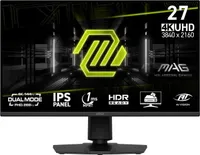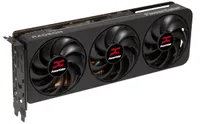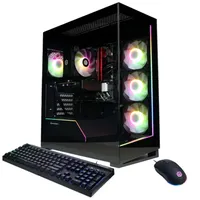Five smart ways to ride out the RAM pricing apocalypse — get the most of your old DDR4, buy a prebuilt or new GPU before prices rise, get a better CPU for your socket, or make your game frames look better with a new monitor
You could also hold out hope for a RAM component bundle deal, but most of those have included DDR4 so far.

In case you haven't noticed, RAM prices have been rising faster than most of us can think of appropriate metaphors other than space. It's causing PC builders and upgraders a lot of consternation and financial pain during this Black Friday deals season, as capable and speedy DDR5 kits now cost as much (or more) than a current-gen gaming console. But just because modern RAM now resembles gold-pressed latinum in both form and value, doesn't mean you have to haggle with a Ferengi at a Micro Center to improve your PC gaming experience. We're here to help, with five smart ways to improve your gaming experience without paying full price for RAM this Black Friday deals season.
1. Get a better gaming monitor to make your games look better
First up, and perhaps the best bang for your upgrade buck, would be to pick up a new monitor – especially if you're still gaming at 1080p. Our recent RTX 5050 testing shows that anything at or above an RTX 5060 or RX 9060 XT is overkill for a 60 Hz 1080p display with modern games. Upping your resolution will both make your games look better and take a lot of the weight off your CPU and RAM. Monitor tech has advanced a lot in recent years, with OLED and QD-OLED models offering the best color and black levels, but IPS panels are still a good option if you're prioritizing value.
The MSI MAG 275UPD is a 27-inch gaming monitor with a 4K IPS panel. It supports Adaptive-Sync and includes HDMI 2.1 along with DisplayPort 1.4a connectivity.
The Alienware AW3425DW is a 34-inch curved QD-OLED gaming monitor that offers excellent visuals with high-end performance. The panel offers a 3440×1440 resolution, 240 Hz refresh rate, 0.03ms response time, and support for both AMD FreeSync Premium Pro and G-Sync. The display also covers 99.3% DCI-P3 and hits 1000 nits peak brightness with VESA DisplayHDR True Black 400 certification.
Want more advice about display upgrades and monitor deal options that will make your existing gaming frames look better? Our monitor editor, Brandon Hill, has hand-picked a few of the best gaming monitor deal options he's seen so far for Black Friday, including a 49-inch monster at its lowest-ever price. Just don't complain to us if you also have to upgrade your desk.
2. Grab a new GPU while some are still selling below MSRP
Of course, buying a GPU is typically a sure-fire way to increase gaming performance. And there are currently some deals that take current-gen gaming cards down to new low prices. And if you are in the market for one, you probably don't want to wait, as memory demand is expected to hit graphics cards as well.
The AMD Radeon RX 9070 XT is a value-for-money GPU offering with excellent performance while maintaining power efficiency. Based on the RDNA 4 architecture, it provides almost the exact numbers as the Nvidia RTX 5070 Ti at a much lower price.
But how do you make sure your new graphics card isn't bottlenecked by your older CPU and RAM? Our resident GPU expert, Jeffrey Kampman, just tested a half-decade-old AMD Ryzen CPU with a Radeon RX 9070 XT to figure out the best performance settings for maximizing image settings and GPU utilization, while keeping your older CPU from being the true bottleneck. That doesn't mean just turning on upscaling, but instead, involves a mix of higher resolutions, higher-quality upscaling settings, and framegen. You can find out more by checking out his test results and settings advice here.
3. What about a CPU upgrade in your existing rig?
Of course, a faster CPU can also increase your gaming performance – especially if you are sticking with 1080p resolution and aiming for triple-digit frame rates for competitive gaming. If you're currently on a DDR4-based platform with enough RAM, your best bet for better performance might be a higher-end CPU. But it may be tough or impossible to find AMD's best AM4-based X3D CPUs for gaming. If you're currently running an older, mid-range AMD CPU, you can still find a good deal on something faster or with more cores. But Intel-based platforms have a better upgrade path if you have a capable DDR4 kit, thanks to the company's decision to support boards with the older memory standard all the way through its Raptor Lake refresh cycle.
The Intel Core i5-13400F is a 10-core (6+4)/16-thread processor from the Raptor Lake range. It features a maximum boost clock speed of 4.6GHz on the P-cores, and although it's a generation older than the Core i5-14400, it offers largely similar performance.
Since those 13th and 14th Gen chips can still better gaming performance than Intel's current Core Ultra models, and 13th/14th Gen CPU stock continues to be pretty good (though compatible DDR4-based boards are starting to become scarce), those who opted for Intel a few years ago may be in a better place in terms of upgrade options as DDR5 prices continue to increas. That's true, at least, as long as your CPU remains stable. But then again, AMD's higher-end chips have issues on that front as well.
Get Tom's Hardware's best news and in-depth reviews, straight to your inbox.
For much more about your RAM-saving CPU upgrade options, check out our in-depth CPU upgrades aren't dead feature, from our newly appointed CPU editor, Jake Roach.
4. Forget DIY. Buy a prebuilt or a gaming laptop before prices increase
If you aren't dead-set on building your own PC, RAM price increases haven't hit prebuilt PCs and gaming laptops yet (though they certainly will soon). Thanks to this current disparity, it's actually cheaper now to buy a PC than to build one yourself – especially if you can find a good Black Friday sale.
This gaming PC boasts an Intel Core Ultra 5 225F, Nvidia GeForce RTX 5060, 2TB of storage, and 32GB of RAM in a case that showcases your parts.
Our systems expert, Andrew Freedman, recently investigated and found that you can save as much as $500 by opting for a prebuilt PC at the moment over building a system that includes DDR5. He's also sorted through the slop to find a few of the best current gaming PC and gaming laptop deals to save you from spending several hundred dollars on a good RAM kit.
5. Hold out hope for a good component bundle with RAM?
Lastly, you could keep an eagle eye out (which we'll be doing as well) for a bundle deal with RAM from Newegg (or Micro Center if there's a store near you). Just note that most of the Newegg bundles we've seen so far have been DDR4-based, and any DDR5 bundles are likely going to be paired with an Intel CPU / motherboard. At the very least, you'll probably have to live with some piece of hardware that your retailer of choice is trying to get rid of, whether that be a sub-par cooler or an older motherboard that's missing features you might want. It still might be a worthwhile option if you can catch the right bundle at the right time. Our news editor, Stephen Warwick, is keeping a close eye on component bundle deals here.
We'll be updating this page (and those linked within it) during the Black Friday/Cyber Monday deals season and beyond to help you find the best upgrade options as the cost of RAM remains too damn high. Frighteningly, we are also seeing some of those high-priced kits sell out, despite costing hundreds more than they did just a few months ago. We'll do our best to keep you abreast of the best (admittedly increasingly bad) upgrade options as long as we can. I just hope we aren't still doing this in 2035.
After a rough start with the Mattel Aquarius as a child, Matt built his first PC in the late 1990s and ventured into mild PC modding in the early 2000s. He’s spent the last 15 years covering emerging technology for Smithsonian, Popular Science, and Consumer Reports, while testing components and PCs for Computer Shopper, PCMag and Digital Trends.





